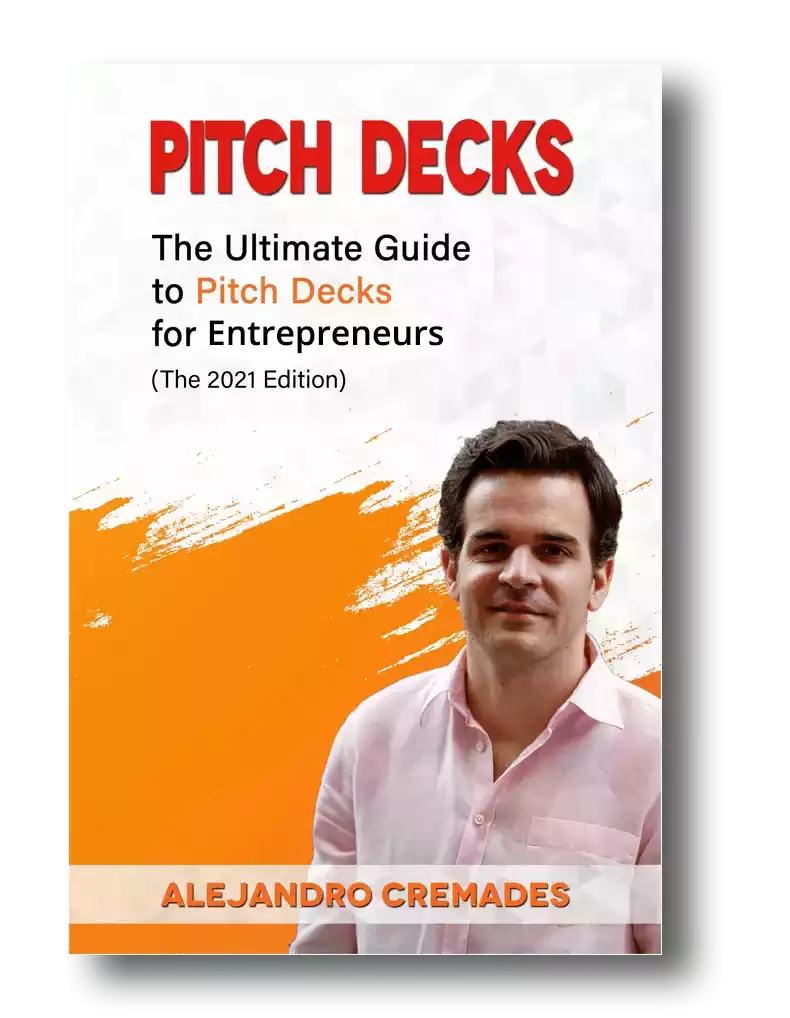What should be the ideal time interval between funding rounds? That’s a crucial question founders are likely to ask at some point during the development of their companies. You’ll need to raise capital for the company at various stages of its lifecycle to achieve its milestones.
Timing the fundraiser strategically is crucial, so you don’t run out of money and continue operations. At the same time, raising funding too soon can result in prematurely diluting ownership and equity. You’ll also need to project that the company is capable of achieving its targeted objectives.

*FREE DOWNLOAD*
The Ultimate Guide To Pitch Decks
Pitching for Funding From One Round to the Next
When approaching investors, your pitch will outline the key performance metrics (KPIs) you hope to reach. These KPIs can include new product development, expanding the customer base, acquiring clients in new locations, or hiring top talent.
Your use of funds slide could also highlight a new contract you intend to get for the company. The pitch for the subsequent funding round should demonstrate that you’ve successfully achieved the earlier goals. That’s how you’ll prove that the brand is robust and you can deliver on your promises.
Efficiency in capital utilization and milestone execution demonstrates to investors that the venture is risk-proof. These signals enable them to invest with confidence. But to achieve these milestones, you need time. You can expect a duration of at least 12 to 18 months for the execution.
Next, add another 6 months for running a new fundraising campaign, bringing the total to at least 30 months. That’s the ideal time interval between funding rounds. But, how about the interval between the company’s different growth stages? Let’s dive in to answering this question.
Bootstrapping to Pre-Seed Funding
At the earliest stage of building the startup, you’re in the process of transforming the idea into a real product. During the bootstrapping stage, you’re unlikely to involve external investors, and aspiring founders typically start it as a side hustle.
You’ll likely invest personal savings, a portion of your salary, or charge the early expenses to a credit card. The initial steps involve building a Minimum Viable Product (MVP), hiring talent, and researching the market for interested users.
This bootstrapping stage can take anywhere from a few months to several years. Several factors can impact the timeline, including the industry in which you work and the current economic landscape.
The complexity of the product you’re developing, business model, finding a product-market fit, and gaining initial traction also matter. Not all founders approach investors for seed funding. Many have successfully built companies using the revenues they earned by selling their basic products.
A great example is Tarun Raisoni, founder of Rahi and ZPE Systems. In an exciting interview on the Dealmakers’ Podcast, he reveals how he bootstrapped both companies with cofounders. They grew 40% to 50% year over year, with Tarun eventually exiting 10 years later.
Bootstrapping allows you to retain 100% of the equity and complete control over the startup. Of course, not every company can sustain itself and scale without external funding. However, the ideal time interval between funding rounds, from bootstrapping to pre-seed, is entirely your prerogative.
As the founder, it’s up to you to decide when the fledgling startup is ready for investor money.

Raise Capital Smarter, Not Harder
- AI Investor Matching: Get instantly connected with the right investors
- Pitch & Financial Model Tools: Sharpen your story with battle-tested frameworks
- Proven Results: Founders are closing 3× faster using StartupFundraising.com
Pre-Seed Funding to Seed Funding
Pre-seed funding is an informal campaign as long as you’re approaching friends, family members, colleagues, and acquaintances. You might consider this the riskiest stage since you’re investing money from external sources into the company.
But if you’re considering raising funding, it signals that you’ve progressed to the next step. At this stage, you should be putting in applications for patents and trademarks to secure the intellectual property you’ve created. You’ll also retain a legal advisor to get the necessary paperwork in order.
If you’re working with cofounders, draft and sign legally-binding cofounders’ agreements to outline the terms and conditions of the partnership. Most startups have a sound business idea at this point and have already started making sales and earning revenue.
Potential Funding Sources
If you’ve successfully determined the product-market fit and have a robust business model, you’ll approach angel investors and VC scouts. Reaching out to micro VC funds is an option if any of the cofounders have prior experience with building startups.
Other potential sources include applying to incubator and accelerator programs or running campaigns on crowdfunding platforms. These campaigns have varying timelines for culminating. For instance, an incubator program can last up to two years until you’re ready to exit and build a company.
On the other hand, accelerator programs have a pre-determined timeframe of three to six months. If you opt for crowdfunding campaigns, you can expect a success interval of anywhere from 30 to 90 days. Here again, you’ll plan for the seed funding round according to the progress you’ve made.
Many nonprofits may also choose to invest in pre-seed stage startups, writing small checks without expecting significant returns. Issuing Simple Agreement for Future Equity (SAFEs) or convertible notes is yet another option.
Typically, there is no set time interval between the pre-seed funding stage and the seed funding stage. Use your judgment to determine when the company is ready for a fresh capital infusion. That is, beyond the $100K to $1M you’ve raised so far.
Keep in mind that storytelling is everything in fundraising. In this regard, for a winning pitch deck to help you here, take a look at the template created by Peter Thiel, Silicon Valley legend (see it here) that I recently covered. Thiel was the first angel investor in Facebook with a $500K check that turned into more than $1 billion in cash.
Remember to unlock the pitch deck template that founders worldwide are using to raise millions below.
Seed Funding to Series A Round
Startups that have reached the seed funding stage are ready with a Minimum Viable Product (MVP). This is typically the beta version that you’ll test on actual users to demonstrate functionality and value for money. Using this MVP, you’ll build an initial customer base and start generating real revenue.
When creating a pitch deck, you’ll include a traction slide with verifiable statistics that demonstrate increasing growth. Add numbers such as customer sign-ups and registrations, orders from vendors, and contracts with enterprise clients. These metrics prove that you have product-market fit.
You’ll also have an impressive team slide with details about the top talent you’ve hired and their track records. Essentially, the pitch should present a compelling narrative about how your MVP is an ideal solution to the problem. And, the audience is expressing interest.
Expect investors to examine metrics that prove customer retention and consistent monthly revenues. At this stage, you should have a growth rate of 20% to secure funding. Yet another metric investors focus on is the monthly burn rate.
This number indicates how long the company can sustain its operations on the capital it raises and the revenues it earns. Do keep in mind that many entrepreneurs have successfully built mega companies by rolling revenues back into the company.
Potential Funding Sources
Earlier, seed-stage startups were considered high-risk ventures, with investors hesitant to support them; however, this is no longer the case. Many venture capitalists, such as Andreessen Horowitz and Khosla Ventures, seek out promising startups and back them as lead investors.
Their strategy is to identify disruptive concepts and gain influence in companies at the earliest stage. As a result, they can claim a board seat, voting rights, and a say in the decision-making processes. They may also be interested in participating in follow-on funding rounds if the company is successful.
Remember that contemporary investors are more than just capital providers; they are also strategic partners. Their objective is to steer the company’s growth trajectory toward long-term success. This, in turn, enables them not only to make substantial returns but also to make a profitable exit.
As for the average check sizes in 2025, you can expect to raise anywhere between $500K and $5M. This figure stood at an average of $3.5M in 2024, with company valuations estimated at $14.8M. Of course, several factors can influence this number, and investors could be open to bigger checks.
The ideal time interval between funding rounds, from seed stage to Series A, is typically two years. Some experts suggest that founders start planning their next fundraising soon after completing a successful round. Others recommend delaying a new campaign until the company requires capital.
While this topic is subject to debate, it’s essential to note that running a campaign requires time and resources. Company CEOs and founders should dedicate their efforts toward efficient utilization of the capital they’ve raised.
They should be executing on the business plan and focusing on growing the company and achieving its next milestones. Engaging in premature fundraising only results in dilution that is best avoided.
Series A Round to Series B Round
As a rule, the ideal time interval between funding rounds has now been increasing by 20% to 30%. This timeframe spans 844 days between the Series A round and the Series B round. Statistics also indicate that in Q1 2025, this median time touched an all-time high of around 34 months or 2.8 years.
The estimated timeframe depends on whether the capital you’ve raised is sufficient to keep the company running efficiently. You also want to ensure that you’ll meet the next milestones. Statistics suggest that, on average, companies raised $16.6M in Q1 and Q2 in 2025.
Although market conditions and other factors influence these check sizes, you can estimate a capital raise of $2M to $15M. If you’ve demonstrated impressive metrics, this figure could be even higher. As for company valuations, they typically range from $10M to $30M.
Once your company has progressed to the Series A growth stage, it’s all about rapid acceleration. The investors expect to see an impressive growth spurt using the funding. You should be growing the team, expanding your go-to-market strategies, and building on the earlier traction.
When you put together the financials slide for pitching to Series B investors, the focus is on revenues. You’ll include monthly recurring revenues (MRR) and annual recurring revenues (ARR), which should be doubling every 6 to 12 months.
Additionally, include metrics such as customer acquisition costs (CAC), annual contract value (ACV), and loan-to-value (LTV). Expect investors to analyze every aspect of the company, including its size, risk factors, performance, management, team, and growth potential.
Since the check sizes are large, they want to check for signals that justify the investment.
Considering how crucial this funding round is, you should know how to create the best pitch decks for Series A rounds. Not sure how to do that? Check out this video in which I have described in detail how it’s done.
Potential Funding Sources
As for the investor class, you’re targeting top venture capitalists and private equity firms. The Series A investors’ list includes names such as Lightspeed, Bessemer Venture Partners, Accel Partners, and others.
Interestingly, in recent years, the percentage of companies successfully reaching the Series A stage has been steadily decreasing. Just 36% of the companies from the 2021 cohort graduated beyond the seed stage. For the year 2023, this percentage dropped to 20%.
But if your company has successfully made it this far, it’s poised to reach long-term business goals. You’ll use the funds to purchase equipment, machinery, and inventory, as well as hire more talent. The money will also go toward expanding marketing and advertising and perhaps strategic acquisitions.
Series B and Beyond to Exit
At the Series B funding milestone, your company is now a mature, later-stage organization. The ideal time interval between funding rounds is no longer relevant if you plan to exit. The exit could involve entering into a merger or acquisition, or issuing an Initial Public Offering (IPO).
If you proceed with the Series B round, expect to approach professional investors, such as hedge funds and private equity firms. Investment banks and later-stage venture capitalists may also participate. Regarding the time frame, you can estimate around 1090 days from Series B to Series C.
At this stage, you can consider expansion beyond state and national borders. The company could become a multinational corporate entity with bases across different global locations.
The Takeaway!
The ideal time interval between funding rounds is largely subjective, as every startup is unique with its own distinct needs. As the founder, it’s up to you to estimate the funding your company needs to achieve its goals and milestones.
Don’t rush to proceed from one growth stage to the next, but instead, make informed and strategic decisions. Work with a mentor and fundraising consultant to guide you through the steps, with a focus on consistent growth. But one that is based on a robust foundation and driven by data.
You may also find our free library of business templates interesting. There, you will find every single template you need to build and scale your business completely, all for free. See it here.





Facebook Comments